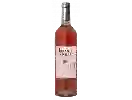
Château de ValcombeTradition Costières-de-Nîmes Rosé
In the mouth this pink wine is a powerful.
This wine generally goes well with pork, poultry or rich fish (salmon, tuna etc).
Taste structure of the Tradition Costières-de-Nîmes Rosé from the Château de Valcombe
Light | Bold | |
Dry | Sweet | |
Soft | Acidic |
In the mouth the Tradition Costières-de-Nîmes Rosé of Château de Valcombe in the region of Rhone Valley is a powerful.
Food and wine pairings with Tradition Costières-de-Nîmes Rosé
Pairings that work perfectly with Tradition Costières-de-Nîmes Rosé
Original food and wine pairings with Tradition Costières-de-Nîmes Rosé
The Tradition Costières-de-Nîmes Rosé of Château de Valcombe matches generally quite well with dishes of pork, rich fish (salmon, tuna etc) or shellfish such as recipes of cajun jumbalaya rice, salmon burger or soy and shrimp noodles.
Details and technical informations about Château de Valcombe's Tradition Costières-de-Nîmes Rosé.
Discover the grape variety: Tchilar
It is certainly one of the best grape varieties in Armenia, where it originates.
Informations about the Château de Valcombe
The Château de Valcombe is one of of the world's great estates. It offers 43 wines for sale in the of Costières-de-Nîmes to come and discover on site or to buy online.
The wine region of Costières-de-Nîmes
The wine region of Costières-de-Nîmes is located in the region of Rhône méridional of Rhone Valley of France. Wineries and vineyards like the Domaine Scamandre or the Château d'Or et de Gueules produce mainly wines red, pink and white. The most planted grape varieties in the region of Costières-de-Nîmes are Mourvèdre, Roussanne and Viognier, they are then used in wines in blends or as a single variety. On the nose of Costières-de-Nîmes often reveals types of flavors of non oak, thyme or raisin and sometimes also flavors of clove, cocoa or coffee.
The wine region of Rhone Valley
The Rhone Valley is a key wine-producing region in Southeastern France. It follows the North-south course of the Rhône for nearly 240 km, from Lyon to the Rhône delta (Bouches-du-Rhône), near the Mediterranean coast. The Length of the valley means that Rhône wines are the product of a wide variety of soil types and mesoclimates. The viticultural areas of the region cover such a distance that there is a widely accepted division between its northern and southern parts.
News related to this wine
The Saint-Véran appellation seen by Kevin Tessieux
Kévin Tessieux, President of the appellation’s winegrower union, shares his perspective on the Saint-Véran appellation and tell us about the origin of its name. This video is taken from the “Rendez-vous avec les vins de Bourgogne” program broadcasted in June 2021. Retrouvez-nous sur les réseaux sociaux : Facebook : https://www.facebook.com/VinsdeBourgogneofficiel Twitter : https://twitter.com/VinsdeBourgogne Instagram : https://www.instagram.com/vinsdebourgogne/ LinkedIn: https://www.li ...
The Mâcon plus appellation seen by Charles Lamboley
Charles Lamboley, marketing and communication director from Vignerons des Terres Secrètes, explains the differences between the appellation Mâcon-Villages and Mâcon plus a geographical denomination. This video is taken from the “Rendez-vous avec les vins de Bourgogne” program (March 2020). The Bourgogne Wine Board (BIVB) invites you to enjoy this video in which Jean-Pierre Renard, Expert Instructor at the Ecole des Vins de Bourgogne, explains the topographical and geological characteristics of t ...
At the heart of the terroirs of Mâcon-Solutré-Pouilly
Sequence from the video « At the heart of the Mâcon terroir » which offer a stroll at the heart of the Mâcon terroir. It offers a focus on Mâcon-Solutré-Pouilly, one of the 27 geographical denominations of the Mâcon appellation. Travel through the terroirs of the Mâcon appellation by watching the full video : https://www.youtube.com/watch?v=GF20y1aBZh8 Both are available in French and English. Our social media: Facebook: https://www.facebook.com/BourgogneWines Twitter: https://twitter.com/Bour ...
The word of the wine: Removal of shoes
In the spring, this operation consists of removing the mound of earth formed at the foot of the vines by ploughing between the rows in the autumn.














